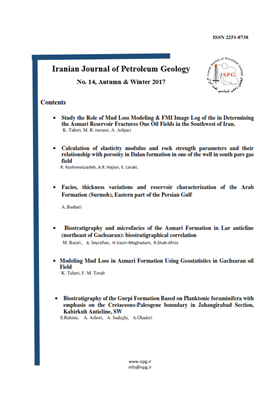Calculation of elasticity modulus and rock strength parameters and their relationship with porosity in Dalan formation in one of the well in south pars gas field
Subject Areas : شاخه های دیگر علوم زمین در ارتباط با زمین شناسی نفتReza Khoshnevis Zadeh 1 * , Alireza Hajian 2 , Ehsan Larki 3
1 -
2 - Islamic Azad University
3 - Islamic Azad University
Keywords: Elastic modulus, Rock strength parameters, DSI tool, Dalan formation.,
Abstract :
The elastic parameters of the rock include the Young modulus, the Poisson ratio, the bulk modulus and the shear modulus. Young modulus with the unconfined compressive strength of rock, are two key parameters in the definition of intact rock. Elastic modulus represents the amount of rock rigidity and is known as the stress-strain chart slope. These parameters represent of rock strength to failure, are important parameters for the stability analysis of wellbore stability. According to the unavailability and cost of core data, and also attended to this fact that the data from the core are not continuous and not available at all points in the well, the uses of DSI logs is one of the best methods for calculating elastic modules. Using these logs, you can also study elastic moduli continuously in a well. In this study, elastic dynamic parameters were calculated using the DSI and density logs for the Dalan Formation. Attention to the fact that the calculated parameters using the velocity of the sound waves are of the type of dynamic parameters, these parameters were have converted to the static modules using appropriate empirical relationships. The rock strength Parameters were calculated using the experimental relationships commonly used in the oil industry to determine rock strength parameters. These parameters were calculated according to static elastic modulus as well as porosity and shale volume. Comparing the values of elastic modulus and rock strength parameters with porosity showed that porosity with elastic modulus and rock strength parameters has an inverse relationship, so that with increases the porosity, the elastic modulus and rock strength parameters have been reduced.

